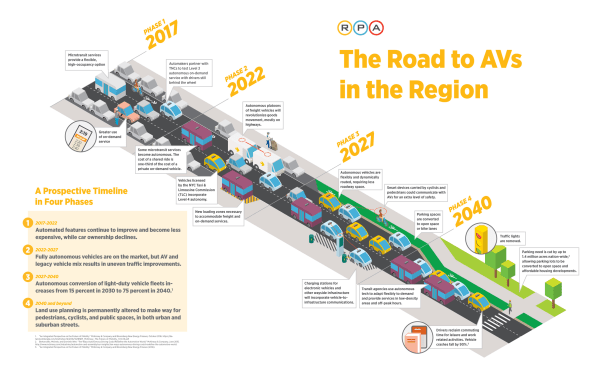Worse Gridlock, More Inequality? 3 Ways Self-Driving Cars Could Change Cities
If we don’t plan for them, that is.
Recently, I heard a friend lament the fact that self-driving cars still haven’t arrived to end his dreaded commute. It’s true: It sometimes feels like autonomous cars have been just over the horizon forever. But for cities, which move at a more geological pace, self-driving cars are approaching at the speed of light, spurring a race to prepare.
Take the Regional Plan Association, a nearly 100-year-old group that leads planning initiatives for the New York-New Jersey-Connecticut area (think airports, bridges, highways, and more). In its entire existence, the association has released its “regional plan,” a huge roadmap for how the area will develop in the coming decades, just three times: in the 1920s, the ’60s, and the ’90s. For the past few years, the group has been hard at work on a much-anticipated fourth plan that will address everything from the housing shortage to sea level rise.

The plan is due out in November. But last week, the group decided to publish a special report on autonomous vehicles early, citing a need for cites to “start preparing now.” By 2045 up to 90% of cars could be autonomous, they explain, and cities should be planning for the changes they’ll bring–both positive and negative–now....MORE
It’s Probably Going To Be A Mess At First
The association’s report is a frank look at how we can expect self-driving cars to change cities and suburbs, and while there are potentially plenty of benefits, some scenarios ain’t pretty.
For instance, one rosy dream of AVs imagines a world where we can sleep or work on our commutes. “[This] could allow users to sleep in bed as they commute or sit at their desk and participate in virtual meetings,” the association writes (much to the chagrin, perhaps, of anyone who finds their work leaking into other parts of their life). At the same time, they caution that there may be unexpected consequences, like skyrocketing congestion, because people are willing to pay a premium for their own rolling bedroom. “Empty personal autonomous vehicles are particularly concerning because there is no time cost for the driver and he or she would also gain the time that would traditionally be spent parking,” they add.
Ridership of public transit could plummet, and the number of cars on the road could boom:
Gridlock in the future could consist of a never ending stream of AVs and manually operated vehicles flowing through the city, with more streets with levels of congestion like Midtown or major arterials (Queens Boulevard or Fordham Road), something that most city dwellers would consider a nightmare scenario....
This is where the technocrat rah-rah boys have their work cut out for them, they have to get it right.
Promises aren't enough.
From The Drive, October 12:
GM Exec Calls out Elon Musk, Says He's 'Full of Crap,' Report Says
Tesla is undoubtedly one of the most controversial automakers in the industry and other manufacturers aren't afraid to back that up. The Silicon Valley brand's contributions to autonomous car development have been substantial, but according to one General Motors executive, Elon Musk's prophecies about his company's advancements are unreal. Literally. In a report from the Sydney Morning Herald, Scott Miller, GM’s director of autonomous vehicle integration, told Australian media in Detroit that Musk's evaluation of Tesla's level 5 capabilities is "full of crap."
GM and Tesla are direct competitors in the race for self-driving cars, so it's not surprising to see a quarrel between the two. However, Miller seemed emphatic that the California company is fibbing about its own technology.
“To think you can see everything you need for a Level 5 autonomous [car] with cameras and radar, I don’t know how you do that,” Miller said. He then noted that you can do a coast-to-coast drive of America with current Level 2 or Level 3 technology, so the fact that Tesla claims it can achieve that feat doesn't mean it has achieved Level 5 autonomy by SAE standards....MORE